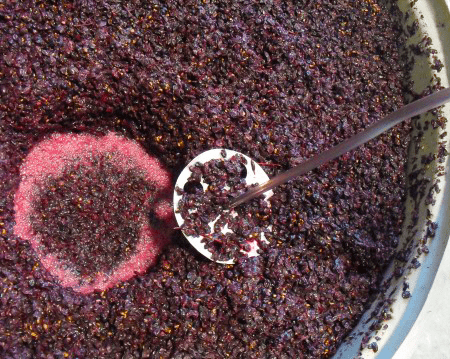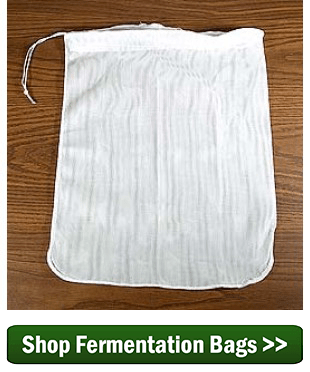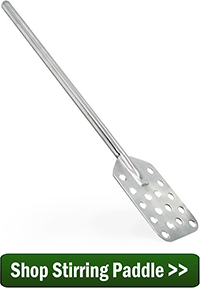 I have started making 5 gal of Blackberry wine and I am using your ingredients. One question is in your wine recipe you say after the first day add the yeast with the fermentation bag still in the must and leave it for an additional 7 days before transferring it to the carboy. Should I continue to stir the wine also ? Do I need to add make up water after removing the bag ?
I have started making 5 gal of Blackberry wine and I am using your ingredients. One question is in your wine recipe you say after the first day add the yeast with the fermentation bag still in the must and leave it for an additional 7 days before transferring it to the carboy. Should I continue to stir the wine also ? Do I need to add make up water after removing the bag ?
Name: Charles P.
State: SC
—–
Hello Charles,
Once you add the yeast you will want to stir the fermenting wine must around as much as you can. The goal is to not allow any of the pulp to become too dry during the fermentation. Stirring it around once or twice a day should be sufficient.
In a winery they call this punching the cap. When fermenting grapes there is so much pulp involved that a thick solid cap is formed. The winemaker has to punch it down with a punch down tool that looks similar to a large potato masher with a long handle.
With your fermentation there is much less pulp. I’m assuming you used around 15 pounds of blackberries to make your five gallons, whereas with a grape wine there would be about 40 pounds, so simply stirring the fermenting wine should be sufficient in your situation.
If you have our regular size fermentation bag, just open it up and stir the pulp so as to circulate the dryer pulp towards the bottom. Rotate the pulp. If you have our jumbo fermentation bag, then it should be left open and rolled backwards over the brim of your primary fermenter. All you need to do is give the pulp a quick stir in kind of a folding manner.
The reason you want to keep stirring the wine must is twofold. The first one is simple. When the pulp becomes to too dry for too long of a period, it provides a perfect place for mold an bacteria to grow – damp, nutritious pulp that is exposed to air. The second reason is if a solid dry layer forms it will interfere with the fermentation. Wine yeast needs air to successfully grow and multiply into a large enough colony to support a healthy, vigorous fermentation. If a dried cap forms it creates a barrier that traps the CO2 gas in the wine must and cuts the air off from the yeast.
As you suggested, once your primary fermentation is done and you are ready to remove the fermentation bag, there will be some loss in volume, but it will not be as much as you might think with your blackberries. What you are looking at now is the plump fruit. Once the fermentation gets hold of it, it won’t be so plump. The fermentation will break down the pectin in the blackberries making the pulp just a shell of what it was before.
If you do find your batch is excessively short then you should top up the wine when going into secondary, but is should not be a major issue. Just be sure to get as much liquid as possible when racking into your secondary fermenter — even if some sediment is coming along with it. Also, when you pull the fermentation bag out, wring it as best you can. The more juice the merrier.
Charles, I hope this answers your questions about stirring fermenting wine. Just remember that stirring the wine must daily to keeping any cap from becoming hard and dried is a critical part of having a healthy, active fermentation.
Happy Winemaking,
Ed Kraus
—–
Ed Kraus is a 3rd generation home brewer/winemaker and has been an owner of E. C. Kraus since 1999. He has been helping individuals make better wine and beer for over 25 years.

Can I stir up my wine daily once it has been pressed and in a glass carboy for three weeks?
I heard it helps metabolize bacteria.
Also after the three weeks of stirring is it ok at this point to add my sulfides?
Thank you,John Disano,RI
John, Once all the wild grape pulp has been removed from the fermentation, there is no need to stir the fermentation daily. The purpose of stirring the fermentation is to make sure that the pulp does not form a dried cap on the surface of the liquid. The dried cap can interfere with the wine yeast’s supply of oxygen, making it hard for the yeast to multiply itself into sufficient numbers. By stirring daily, any cap can be broken up and mixed down into the juice. In the secondary fermentation there is no pulp and therefor no reason to stir.
It sounds to me that you may be referring to the malolactic fermentation (MLF) that occurs in secondary. If you are pitching a malolactic culture after pressing, you are correct that stirring the fine lees can help feed the bacteria. Stirring at this point must be done carefully so as not to expose the wine to too much oxygen, and it is sometimes recommended to purge headspace with inert gas each time it’s done. And for your other point, you do want to make sure your MLF is complete before adding sulfite since the bacteria are very sensitive to SO2.
I gently “punched my cap” and my fermentation seems to have stalled…
Hi Ed,
I am making a rhubarb wine with a recipe I have used successfully many times before. With this batch, disaster has struck. I believe the cause to be the potassium metabisulfite. My husband purchased this particular bag of metabisulfite at a garage sale so it possibly is too old. I added 5 teaspoons of the metabisulfite to my 5-gallon primary fermenter which had the rhubarb, water, and sugar, stirred, and left everything for 17 hours. I dissolved the wine yeast in a cup of warm water with a bit of sugar, ascertained that the yeast was working robustly, and added that mixture, together with yeast nutrient, to the rhubarb mixture. Result: the yeast died. I have now added yeast determined beforehand to be working 4 separate times to the rhubarb mixture, with the same result. I read about your splashing advice earlier this morning, and just tried that, but it is too early to know yet if that will help.
Do you have any advice? I really hate to squander the labor spent in harvesting and preparing all that rhubarb. But if there is no hope, I don’t want to waste any more yeast either.
Looking forward to your reply,
Maryann
Maryann, adding to much sulfite is more common that you may think. There is still hope for your wine. Splashing the wine is the only option for saving the juice. You may have to do the splashing of the juice multiple times to get it to leave. You can keep repeating this process until you’ve over come the abundance of sulfite in the wine.
Too Much Sulfite In My Wine
https://blog.eckraus.com/too-much-sulfite-wine-homemade
I recently started a batch of wine and the weather turned cold can I put it next to my gas logs to keep it warm enough to continue fermentation
Mike, putting it next to the gas logs may keep it too warm and you do not want that. The article posted below will give you a couple of options for keeping the juice at a safe temperature during fermentation.
Keeping A Fermentation Warm
https://blog.eckraus.com/keeping-a-fermentation-warm
Can l remove the fruit pulp before my primary fermentation?
Rhoel, When making wine with your own fruit, to achieve optimal flavor, color and body, we recommend fermenting with the pulp and skin. This is what provides most of the color and body. You should still keep the pulp in with the fermentation for the first 5 to 7 days, during the primary fermentation. For more information, please see the article link posted below.
Should I use The Juice Or The Pulp
https://blog.eckraus.com/should-i-use-the-juice-or-the-pulp
I know this isn’t wine per se, but I’m attempting a hard ginger beer as my first fermentation project. Right now it is just the macerated ginger, turmeric, lalvin ec-118 yeast, and sugar mixture (3 parts organic cane sugar/2 parts black strap molasses/1 part raw honey) in the primary vessel. I will be adding a combination of citrus juices and spices for secondary fermentation, most likely with some additional sugar/water mixture. My question is as follows- if I’m going to be racking once secondary is complete/prior to bottling any way, should I still bother racking my brew to a secondary vessel, or is simply adding the ingredients for secondary ferment to the same vessel a viable option? Thanks in advance
Either way will work, but there will be subtle differences in the flavor. When eliminating that first racking you are giving the enzymes from the yeast more time to break down the ingredients. You could equate this to getting more flavor from the produce, but it can (and I emphasize “can”) add more bitterness from tannins and other proteins. This is something that will need to be experimented, because either way can work.
I’m making a mulberry wine with 5kg of fruit. I’m using a steel container with a smaller neck size than body for my primary fermentation. When I added yeast it, it was almost 90% full and I covered it with a cotton cloth and ties it around the next of the bottle. 16 hours down, I see the cap has came in contact with the cloth. Will it push further and overflow in coming hours? Should I transfer the wine to a small container? If I’m transferring it now, will it equally disperse? I mean the liquid and the solid components and also the yeast.
I’ve added one third of my yeast nutrient already and will add remaining in two – three days.
Help me if possible. What should I do to save it.
Your best option is to leave it be. The clothe should be able to keep the foam from spilling over. It will be a little messy but other than that, fine. You can separate it into two container. With the fermentation that active, everything is dispersed evenly enough.
How can you separate it into another container? With a siphon? Thanks!
Erika, siphoning is how you transfer the liquid from one container to the next. The article posted below will explain the importance of racking your wine as well as suggestions on how to do so,
Racking Wine
https://eckraus.com/wine-making-racking/
I purchased Vinters Best strawberry juice for wine. I have some fresh rhubarb in my garden I would like to add. At what point would I add it? As an additive to my secondary or should I cook it down and puree it and add to my primary?
Shawn, typically you add any fruit pulp during the primary stage of fermentation which is about 5-7 days. You just want to cut up the rhubarb and add it your fermenter.
Just a helping tip on the rhubarb.
Freezing the rhubarb before addition will break down the structure to allow better release of acid and flavour, otherwise it tends to stay as solid cubes.
Making blackberry wine. Yesterday I added yeast i put top on firmly. This morning a section of the top has been pushed up and some fluid on the outside. Should I cover it tightly and if so with a top or clear wrap and airlock?
Kaye, during the primary fermentation, we actually do not recommend using the lid or airlock. During the primary stage of fermentation, we recommend using a thin towel to cover the fermenter.
Using An Airlock During Primary Fermentation
https://eckraus.com/wine-making-stuck-5
Can I, should I stir during the initial, 24 hr pre-fermetation, sterilization step? (Using muscadines.)
Pam, it really is not necessary to stir the juice the first 24 hours. Just make sure that you do stir daily after the yeast is added and before the pulp is removed.
Hi. I’m making Apple wine and had to put the apples straight in the liquid because I didn’t have a bag big enough. The Apple is above the level of the liquid. Is this ok? Thank.
Hello Ed. I am making pineapple wine.
I am using 100% pineapple juice from concentrate. I have 5 gallons going right now.
My question is do I need to add pectic enzyme if I am using juice? I already did this batch, but would like an answer for future projects.
How about tannin? Are either important if not using fruit?
Charles, It is not required to use the pectic enzyme when making wine from frozen concentrate. However having the appropriate amount of tannin in a wine is important as it provides the proper zest to the wine. Below we have posted our recipe for frozen concentrate wine for more information.
Frozen Concentrate Recipe
https://eckraus.com/content/frozenconcentratewine.pdf
Greetings from India Mr. Kraus. I’ve been diligently following your guidance and tutorials on wine-making and finally got inspired to take a shot. You are so good, take a bow Sir… So I got inspired and bought 2 litres of freshly crushed sugar-cane juice mixed with 1 small lime, [2] added bread-yeast — the best I can do here in India where the wine industry is yet to be born — and let it set. [3] Split the mixture into 3 and put in 3 bottles with about 40% space above in each, [4] sealed them with cork to avoid Oxygenation and I stir the mixture twice a day to prevent sediment formation at the top… The liquid turned from fresh crushed green to brown in a day and appears to be forming well as I see small bubbles {I presume of CO2} forming and moving up in all 3 of them… Question — [[1]] How many days do I let it ferment? [[2]] Should I ever open the cap and let any oxygen in or always keep it shut during the time? [[3]] It is hot here in India {30+ degrees} so I kept it in my kitchen cellar where it is around 27 celcius in the heat of the day and cools to around 22 at nights. Is that temp variation acceptable Sir?
Hello, I’m making cranberry wine and I’m in the primary stage. I added my yeast , so should I stir everything for 1 to 2 days and then stop or stir until the primary fermentation is complete?